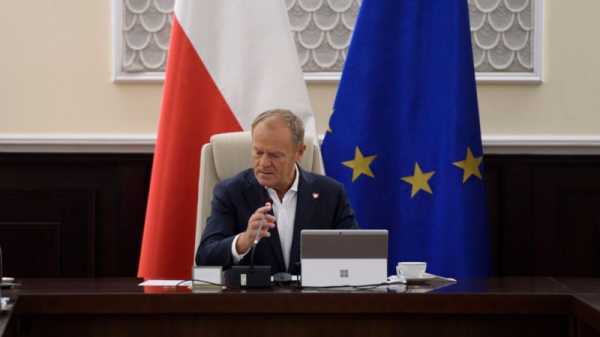
The European security order has broken down. You might think that’s an overstatement. NATO is alive and well. The Organization for Security and Cooperation (OSCE) in Europe is still functioning at a high level.
Of course, there’s the possibility of a major war breaking out between Russia and Ukraine. But would Russian President Vladimir Putin really take such an enormous risk? Moreover, periodic conflicts in that part of the world — in Ukraine since 2014, in Georgia in 2008, in Transnistria between 1990 and 1992 — have not escalated into Europe-wide wars. Even the horrific bloodletting of Yugoslavia in the 1990s was largely contained within the borders of that benighted former country, and many of the Yugoslav successor states have joined both the European Union and NATO.
In Ukraine, More Than European Peace Is at Stake
READ MORE
So, you might argue, the European security order is in fine shape, and it’s only Putin who’s the problem. The United States and Europe will show their resolve in the face of the Russian troops that have massed at the border with Ukraine, Putin will accept some face-saving diplomatic compromise and the status quo will be restored.
Even if that were to happen and war is averted this time, Europe is still in a fundamental state of insecurity. The Ukraine conflict is a symptom of this much deeper problem.
The current European security order is an overlay of three different institutional arrangements. NATO is the surprisingly healthy dinosaur of the Cold War era with 30 members, a budget of $3 billion and collective military spending of over a trillion dollars.
Embed from Getty Images
Russia has pulled together a post-Cold War military alliance of former Soviet states, the Collective Security Treaty Organization (CSTO), that is anemic by comparison with a membership that includes only Armenia, Belarus, Kazakhstan, Kyrgyzstan and Tajikistan. Instead of expanding, the CSTO is shrinking, having lost Azerbaijan, Georgia and Uzbekistan over the course of its existence.
And then there’s the Helsinki framework that holds East and West together in the tenuous OSCE. Neither Russia nor its military alliance was able to prevent the march of NATO eastward to include former Soviet republics. Neither NATO nor the OSCE was able to stop Russia from seizing Crimea, supporting a separatist movement in eastern Ukraine or orchestrating “frozen conflicts” in Georgia and Moldova.
Presently, there are no arms control negotiations between East and West. China became Russia’s leading trade partner about a decade ago, and the United States and European countries have only fallen further behind since. Human rights and civil liberties are under threat in both the former Soviet Union and parts of the European Union.
So, now do you understand what I mean by the breakdown of the European security order? The Cold War is back, and it threatens once again to go hot, if not tomorrow then perhaps sometime soon.
So, yes, Ukrainian sovereignty must be defended in the face of potential Russian aggression. But the problem is much bigger. If we don’t address this bigger problem, then we’ll never really safeguard Ukraine, deal with Russia’s underlying concerns of encirclement or tackle the worrying militarization of Europe. What we need is Helsinki 2.0.
The Origins of Helsinki 1.0
In the summer of 1985, I was in Helsinki after a stint in Moscow studying Russian. I was walking down one of the streets in the Finnish capital when I came across a number of protesters holding signs.
“Betrayal!” said one of them. “Appeasement!” said another. Other signs depicted a Russian bear pressing its claws into the then-Baltic republics of Lithuania, Latvia and Estonia.

Make Sense of the World
Unique Insights from 2,500+ Contributors in 90+ Countries
I agree to receive emails and other content from Fair Observer. I understand that I may repeal my consent at any time. You can review our Privacy Policy and Terms of Use for further information .
I’d happened on this band of mostly elderly protesters outside a building where dignitaries from around the world had gathered to celebrate the 10th anniversary of the Helsinki Accords. At the time, I had only a vague understanding of the agreement, knowing only that it was a foundational text for East-West détente, an attempt to bridge the Iron Curtain.
As I found out that day, not everyone was enthusiastic about the Helsinki Accords. The pact, signed in 1975 by the United States, Canada, the Soviet Union and all European countries except Albania, finally confirmed the post-war borders of Europe and the Soviet Union, which meant acknowledging that the Baltic states were not independent but instead under the Kremlin’s control. To legitimize its control over the Baltics in particular, a concession it had been trying to win for years, the Soviet Union was even willing to enter into an agreement mandating that it “respect human rights and fundamental freedoms, including the freedom of thought, conscience, religion or belief, for all without distinction as to race, sex, language or religion.”
At the time, many human rights advocates were skeptical that the Soviet Union or its Eastern European satellites would do anything of the sort. After 1975, “Helsinki” groups popped up throughout the region — the Moscow Helsinki Group, Charter 77 in Czechoslovakia — and promptly discovered that the Communist governments had no intention of honoring their Helsinki commitments, at least as they pertained to human rights.
Most analysts back then saw the recognition of borders as cold realpolitik and the human rights language as impossibly idealistic. History has proved otherwise. The borders of the Soviet Union had an expiration date of 15 years. And, ultimately, it would be human rights — rather than war or economic sanctions — that spelled the end of the Soviet Union and the Warsaw Pact. Change came in the late 1980s from ordinary people who exercised the freedom of thought enshrined in the Helsinki Accords to protest in the streets of Vilnius, Warsaw, Prague and Tirana. The decisions made in 1975 ensured that the transitions of 1989-91 would be largely peaceful.
After the end of the Cold War, the Helsinki Accords became institutionalized in the OSCE, and briefly, that promised to be the future of European security. After all, the collapse of the Soviet Union meant that NATO no longer had a reason for existence.
Embed from Getty Images
But institutions do not die easily. NATO devised new missions for itself, becoming involved in out-of-area operations in the Middle East, intervening in the Yugoslav wars and beginning in 1999 expanding eastward. The first Eastern European countries to join were the Czech Republic, Hungary and Poland, which technically brought the alliance to Russia’s very doorstep (since Poland borders the Russian territory of Kaliningrad). NATO expansion was precisely the wrong answer to the question of European security — my first contribution to Foreign Policy in Focus back in 1996 was a critique of expansion — but logic took a backseat to appetite.
The OSCE, meanwhile, labored in the shadows. With its emphasis on non-military conflict resolution, it was ideally suited to the necessities of post-Cold War Europe. But it was an unwieldy organization, and the United States preferred the hegemonic power it wielded through NATO.
This brings us to the current impasse. The OSCE has been at the forefront of negotiating an end to the war in eastern Ukraine and maintains a special monitoring mission to assess the ceasefire there. But NATO is mobilizing for war with Russia over Ukraine, while Moscow and Washington remain as far apart today as they were during the Cold War.
The Helsinki Accords were the way to bridge the unbridgeable in 1975. What would Helsinki 2.0 look like today?
Toward Helsinki 2.0
The Helsinki Accords were built around a difficult compromise involving a trade-off on borders and human rights. A new Helsinki agreement needs a similar compromise. That compromise must be around the most important existential security threat facing Europe and indeed the world: climate change.
As I argue in a new article in Newsweek, “In exchange for the West acknowledging Russian security concerns around its borders, Moscow could agree to engage with its OSCE partners on a new program to reduce carbon emissions and transition from fossil fuels. Helsinki 2.0 must be about cooperation, not just managing disagreements.”
The Russian position on climate change is “evolving,” as politicians like to say. After years of ignoring the climate crisis — or simply seeing it as a good opportunity to access resources in the melting Arctic — the Putin administration change its tune last year, pledging to achieve carbon neutrality by 2060.
Embed from Getty Images
There’s obviously room for improvement in Russia’s climate policy — as there is in the United States and Europe. But that’s where Helsinki 2.0 can make a major contribution. The members of a newly energized OSCE can engage in technical cooperation on decarbonization, monitor country commitments to cut emissions, and apply new and stringent targets on a sector that has largely gotten a pass: the military. It can even push for the most effective decarbonization strategy around: demilitarization.
What does Russia get out of the bargain? A version of what it got in 1975: reassurances around borders.
Right now, everyone is focused on the question of NATO expansion as either an unnecessary irritant or a necessary provocation in American-Russian relations. That puts too much emphasis on NATO’s importance. In the long term, it’s necessary to reduce the centrality of NATO in European security calculations and to do so without bulking up all the militaries of European states and the EU. By all means, NATO should be going slow on admitting new members. More important, however, are negotiations as part of Helsinki 2.0 that reduce military exercises on both sides of Russia’s border, address both nuclear and conventional buildups, and accelerate efforts to resolve the “frozen conflicts” in Ukraine, Georgia and Moldova. Neither NATO nor the CSTO is suited to these tasks.
As in 1975, not everyone will be satisfied with Helsinki 2.0. But that’s what makes a good agreement: a balanced mix of mutual satisfaction and dissatisfaction. More importantly, like its predecessor, Helsinki 2.0 offers civil society an opportunity to engage — through human rights groups, arms control advocates, and scientific and educational organizations. This might be the hardest pill for the Kremlin to swallow, given its hostile attitude toward civil society. But the prospect of securing its borders and marginalizing NATO might prove simply too irresistible for Vladimir Putin.
The current European security order is broken. It can be fixed by war. Or it can be fixed by a new institutional commitment by all sides to negotiations within an updated framework. That’s the stark choice when the status quo cannot hold.
*[This article was originally published by FPIF.]
Source: fairobserver.com



